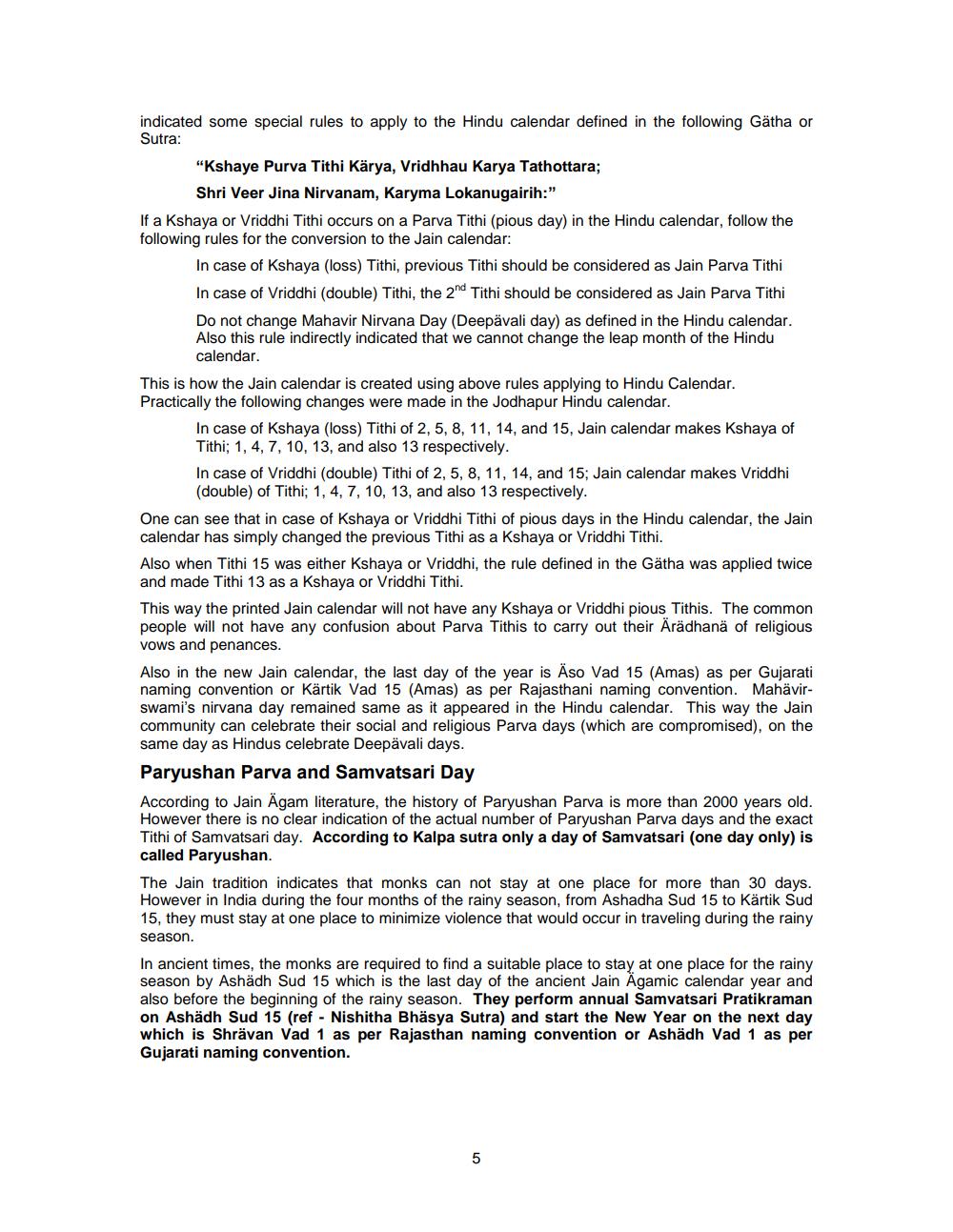Book Title: Historical Perspective of Samvatsari Day and Jain Calendar Author(s): Pravin K Shah Publisher: JAINA Education Committee View full book textPage 5
________________ indicated some special rules to apply to the Hindu calendar defined in the following Gätha or Sutra: "Kshaye Purva Tithi Kärya, Vridhhau Karya Tathottara; Shri Veer Jina Nirvanam, Karyma Lokanugairih:" If a Kshaya or Vriddhi Tithi occurs on a Parva Tithi (pious day) in the Hindu calendar, follow the following rules for the conversion to the Jain calendar: In case of Kshaya (loss) Tithi, previous Tithi should be considered as Jain Parva Tithi In case of Vriddhi (double) Tithi, the 2nd Tithi should be considered as Jain Parva Tithi Do not change Mahavir Nirvana Day (Deepävali day) as defined in the Hindu calendar. Also this rule indirectly indicated that we cannot change the leap month of the Hindu calendar. This is how the Jain calendar is created using above rules applying to Hindu Calendar. Practically the following changes were made in the Jodhapur Hindu calendar. In case of Kshaya (loss) Tithi of 2, 5, 8, 11, 14, and 15, Jain calendar makes Kshaya of Tithi; 1, 4, 7, 10, 13, and also 13 respectively. In case of Vriddhi (double) Tithi of 2, 5, 8, 11, 14, and 15; Jain calendar makes Vriddhi (double) of Tithi; 1, 4, 7, 10, 13, and also 13 respectively. One can see that in case of Kshaya or Vriddhi Tithi of pious days in the Hindu calendar, the Jain calendar has simply changed the previous Tithi as a Kshaya or Vriddhi Tithi. Also when Tithi 15 was either Kshaya or Vriddhi, the rule defined in the Gätha was applied twice and made Tithi 13 as a Kshaya or Vriddhi Tithi. This way the printed Jain calendar will not have any kshaya or Vriddhi pious Tithis. The common people will not have any confusion about Parva Tithis to carry out their Aradhana of religious vows and penances. Also in the new Jain calendar, the last day of the year is Äso Vad 15 (Amas) as per Gujarati naming convention or Kärtik Vad 15 (Amas) as per Rajasthani naming convention. Mahävirswami's nirvana day remained same as it appeared in the Hindu calendar. This way the Jain community can celebrate their social and religious Parva days (which are compromised), on the same day as Hindus celebrate Deepavali days. Paryushan Parva and Samvatsari Day According to Jain Agam literature, the history of Paryushan Parva is more than 2000 years old. However there is no clear indication of the actual number of Paryushan Parva days and the exact Tithi of Samvatsari day. According to Kalpa sutra only a day of Samvatsari (one day only) is called Paryushan. The Jain tradition indicates that monks can not stay at one place for more than 30 days. However in India during the four months of the rainy season, from Ashadha Sud 15 to Kärtik Sud 15, they must stay at one place to minimize violence that would occur in traveling during the rainy season. In ancient times, the monks are required to find a suitable place to stay at one place for the rainy season by Ashädh Sud 15 which is the last day of the ancient Jain Agamic calendar year and also before the beginning of the rainy season. They perform annual Samvatsari Pratikraman on Ashädh Sud 15 (ref - Nishitha Bhäsya Sutra) and start the New Year on the next day which is Shrävan Vad 1 as per Rajasthan naming convention or Ashädh Vad 1 as per Gujarati naming convention.Page Navigation
1 ... 3 4 5 6 7 8 9 10 11
